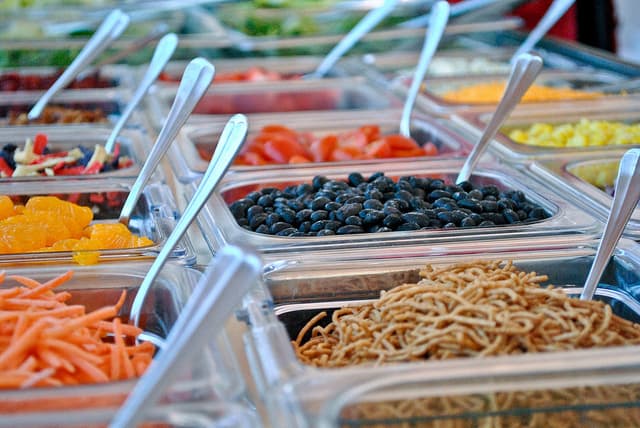


I’ll never forget a story a friend once told me about a phase her little boy went through when he wouldn’t eat vegetables. It all started with a strong dislike of cauliflower, and grew to include pretty much every vegetable. He didn’t even like when other food on his plate was too close to the vegetables. After many struggles, it got to the point where my friend had steam them, puree them, and try to hide them in his food. She even hid beets and zucchini in his birthday cake!
As a parent, it’s discouraging when your kids resist veggies with every fiber of their little beings. But whether you children are veggie-phobes or total veggie-lovers, taking a fun, creative approach to serving up vegetables may be the key to upping their daily intake in a way that is enjoyable and educational for both you and them. Making an at-home, DIY salad bar is a great way to encourage little ones to take ownership over their food, make healthy choices, try new ingredients, and learn some fun nutrition basics.
There really are no rules when it comes to making a DIY salad bar. At Kennolyn Camps, we try and provide as much variety as possible in our twice-daily salad bar, so that everyone will find something they like. We like to use lots of vibrant, fresh veggies, and we keep things as wholesome and natural as possible. When it comes to your own home salad bar, providing an array of colorful veggies in your salad bar ensures that your child will get a wide variety of nutrients in their bowl. In fact, this can be a great time to introduce the idea of vitamins and minerals to your children, using colors as a jumping off point. For instance, you can explain that different colors in veggies signify different nutrients, and it is so important to eat all colors of veggies to ensure we get all the nutrients our bodies need.
Before you build your salads, take the time to walk your child through each of the ingredients and taste them all together. One study on parental influence on eating behavior found that kids model the eating behaviors of parents. So, if they see you eating you enthusiastically enjoying your veggies, they are more likely to do so themselves. As you taste each ingredient, ask your kids to describe what each tastes like, and get them to pronounce the names of all the ingredients. Coming up with silly names for the veggies (sergeant spinach, cuckoo cucumber) is a great way to make the veggies seem less intimidating.
When it comes to setting up your salad bar, buy an inexpensive set of small tupperware containers to put each of your ingredients in. That way, you can keep them in the fridge and pull them out anytime for easy salad bar setup. Just make sure that when an ingredient gets low, you finish it completely rather than topping it up with fresh stuff. You want to make sure that nothing spoils at the bottom of the container. This method also helps you keep track of which ingredients need replenishing.
Let your kids choose the ingredients they want and arranging them in their bowls. Giving kids this sense of ownership and choice over their food means they will be more likely to try new things! Here are the main ingredient categories that we think every salad bar should have.
It’s important to show your children how to build a well-balanced salad. If they are completely left to their own devices, they may be inclined to skimp on the greens and load up on the cheese and bacon bits. As you build your own salad, demonstrate to them what a healthy serving size looks like and how much of each ingredient is appropriate.
The most important thing to keep in mind when it comes time to eat is that you have fun with it. Get really creative in arranging the ingredients artfully atop the greens. You could even have prizes for who tries the most new ingredients, who makes the most colorful salad, or who comes up with the silliest veggie nickname. Showing your kids that nutritious food (yes, even veggies), can be fun, is critical in helping them develop healthier eating habits and making healthy food choices.
If you’d like to learn more about how your kids can develop healthy eating habits in the camp community, get in touch with us today. In fact, we’d love to know what healthy ingredients were a hit on your own home salad bar so we can add them to our twice-daily salad bar at camp!
Salad Bar Photo Credit: Flickr user larryjh1234